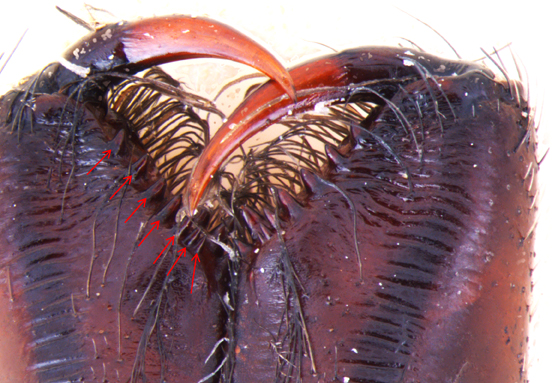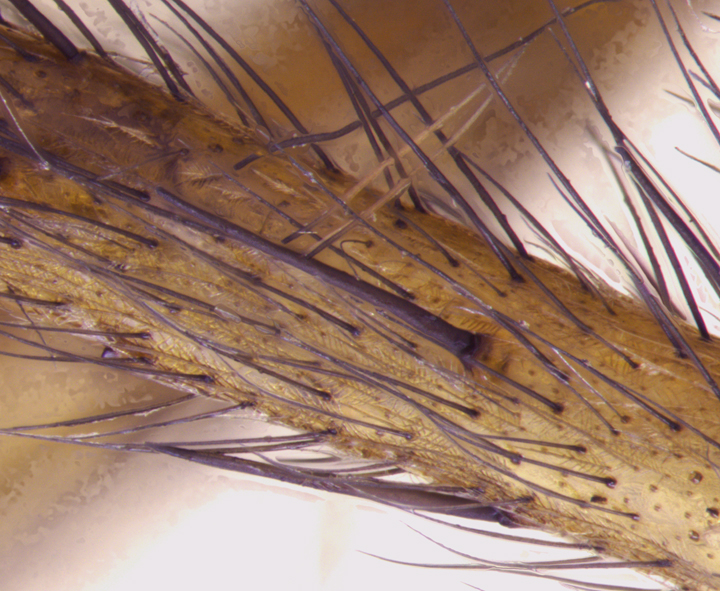Adaptations
Almost everybody knows that spiders are known for having four
pairs of legs, but did you know that they have a total of six pairs of appendages? The hobo
spider has fours pairs of “true” and jointed legs, one pair of
chelicerae, and one pair of pedipalps. The chelicerae and pedipalps are actually modified legs. As you
 may have guessed,
the “true” legs are used for walking, but what about the
chelicerae and pedipalps? The chelicerae are used for feeding,
but they also contain the fangs and venom. The pedipalps also
are used for feeding, but they are used for reproductive
purposes too. The ends of the pedipalps on the male spiders are
swollen at the ends. All of these adaptations have separated
the spiders and other members of the Chelicerata from the other
arthropods, and they have also allowed the spider to be more
successful in its habitat.
may have guessed,
the “true” legs are used for walking, but what about the
chelicerae and pedipalps? The chelicerae are used for feeding,
but they also contain the fangs and venom. The pedipalps also
are used for feeding, but they are used for reproductive
purposes too. The ends of the pedipalps on the male spiders are
swollen at the ends. All of these adaptations have separated
the spiders and other members of the Chelicerata from the other
arthropods, and they have also allowed the spider to be more
successful in its habitat.
The hobo spider has a skeleton for structure and support, but
it is much different than the skeleton of humans. Humans
have a skeleton on the inside of their body so it is called an
endoskeleton, but spiders actually have a chitin-ba sed skeleton
on the outside of their bodies called an exoskeleton. The
main function of the exoskeleton is protection, support, and a
site for muscle attachment. There are four main regions of
the exoskeleton. They include the epicuticle, procuticle,
epidermis, and basement membrane. The epicuticle prevents the
spider from drying out, and the procuticle is made up of chitin fibers and
a protein matrix for support. The epidermis secretes the
cuticle layers and the basement membrane is there for support.
sed skeleton
on the outside of their bodies called an exoskeleton. The
main function of the exoskeleton is protection, support, and a
site for muscle attachment. There are four main regions of
the exoskeleton. They include the epicuticle, procuticle,
epidermis, and basement membrane. The epicuticle prevents the
spider from drying out, and the procuticle is made up of chitin fibers and
a protein matrix for support. The epidermis secretes the
cuticle layers and the basement membrane is there for support.
The exoskeleton of the hobo spider does not grow with the spider,
so this poses a problem when the spider gets bigger. Spiders
and other members of the arthropods solve this problem by a process
called molting. Molting is when the organism loses their old
exoskeleton, grow a little larger, and then produce a new
exoskeleton that fits their new body size. This allows the
hobo spider to grow in size without having to
lose the support and protection of the exoskeleton.
The hobo spider has 8 eyes that are arranged into two rows of 4.
There are many species of spiders who have compound eyes that
allow them to see extremely well. This is not the case
with the hobo spider. Its vision is not that great and it
has a hard time distinguishing things from more than a couple of
feet away. Although, what the hobo spider lacks in vision, it
makes up for with its ability to feel around in its environment.
8 eyes that are arranged into two rows of 4.
There are many species of spiders who have compound eyes that
allow them to see extremely well. This is not the case
with the hobo spider. Its vision is not that great and it
has a hard time distinguishing things from more than a couple of
feet away. Although, what the hobo spider lacks in vision, it
makes up for with its ability to feel around in its environment.
Spiders, as I’m sure you know, are able to spin webs made out of
silk. This is also true for the hobo spider. Female hobo
spiders produce webs and wait in them for their prey. At the
end of their legs, Tegenaria agrestis possess
mechanoreceptors. Using these mechanoreceptors, the spider is
able to detect different pressures being generated across the
surfaces of the web. This allows it to sense where and when a
prey item lands on the web. When the prey does land on the web, the hobo spider
quickly bites it, injects it with venom, and then consumes
it. Having these mechanoreceptors allows the hobo spider to
obtain food while having poor vision.

Nutrition
Home
